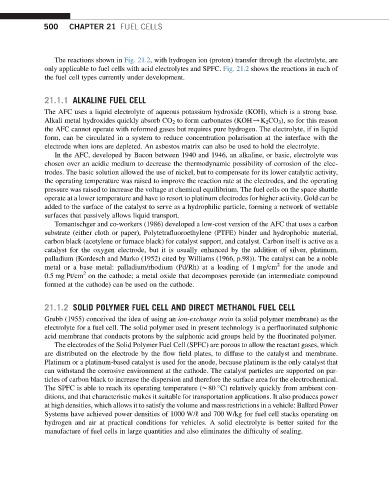Page 507 - Advanced thermodynamics for engineers
P. 507
500 CHAPTER 21 FUEL CELLS
The reactions shown in Fig. 21.2, with hydrogen ion (proton) transfer through the electrolyte, are
only applicable to fuel cells with acid electrolytes and SPFC. Fig. 21.2 shows the reactions in each of
the fuel cell types currently under development.
21.1.1 ALKALINE FUEL CELL
The AFC uses a liquid electrolyte of aqueous potassium hydroxide (KOH), which is a strong base.
Alkali metal hydroxides quickly absorb CO 2 to form carbonates (KOH/K 2 CO 3 ), so for this reason
the AFC cannot operate with reformed gases but requires pure hydrogen. The electrolyte, if in liquid
form, can be circulated in a system to reduce concentration polarisation at the interface with the
electrode when ions are depleted. An asbestos matrix can also be used to hold the electrolyte.
In the AFC, developed by Bacon between 1940 and 1946, an alkaline, or basic, electrolyte was
chosen over an acidic medium to decrease the thermodynamic possibility of corrosion of the elec-
trodes. The basic solution allowed the use of nickel, but to compensate for its lower catalytic activity,
the operating temperature was raised to improve the reaction rate at the electrodes, and the operating
pressure was raised to increase the voltage at chemical equilibrium. The fuel cells on the space shuttle
operate at a lower temperature and have to resort to platinum electrodes for higher activity. Gold can be
added to the surface of the catalyst to serve as a hydrophilic particle, forming a network of wettable
surfaces that passively allows liquid transport.
Tomantschger and co-workers (1986) developed a low-cost version of the AFC that uses a carbon
substrate (either cloth or paper), Polytetrafluoroethylene (PTFE) binder and hydrophobic material,
carbon black (acetylene or furnace black) for catalyst support, and catalyst. Carbon itself is active as a
catalyst for the oxygen electrode, but it is usually enhanced by the addition of silver, platinum,
palladium (Kordesch and Marko (1952) cited by Williams (1966, p.98)). The catalyst can be a noble
2
metal or a base metal: palladium/rhodium (Pd/Rh) at a loading of 1 mg/cm for the anode and
2
0.5 mg Pt/cm on the cathode; a metal oxide that decomposes peroxide (an intermediate compound
formed at the cathode) can be used on the cathode.
21.1.2 SOLID POLYMER FUEL CELL AND DIRECT METHANOL FUEL CELL
Grubb (1955) conceived the idea of using an ion-exchange resin (a solid polymer membrane) as the
electrolyte for a fuel cell. The solid polymer used in present technology is a perfluorinated sulphonic
acid membrane that conducts protons by the sulphonic acid groups held by the fluorinated polymer.
The electrodes of the Solid Polymer Fuel Cell (SPFC) are porous to allow the reactant gases, which
are distributed on the electrode by the flow field plates, to diffuse to the catalyst and membrane.
Platinum or a platinum-based catalyst is used for the anode, because platinum is the only catalyst that
can withstand the corrosive environment at the cathode. The catalyst particles are supported on par-
ticles of carbon black to increase the dispersion and therefore the surface area for the electrochemical.
The SPFC is able to reach its operating temperature (w80 C) relatively quickly from ambient con-
ditions, and that characteristic makes it suitable for transportation applications. It also produces power
at high densities, which allows it to satisfy the volume and mass restrictions in a vehicle: Ballard Power
Systems have achieved power densities of 1000 W/[ and 700 W/kg for fuel cell stacks operating on
hydrogen and air at practical conditions for vehicles. A solid electrolyte is better suited for the
manufacture of fuel cells in large quantities and also eliminates the difficulty of sealing.

